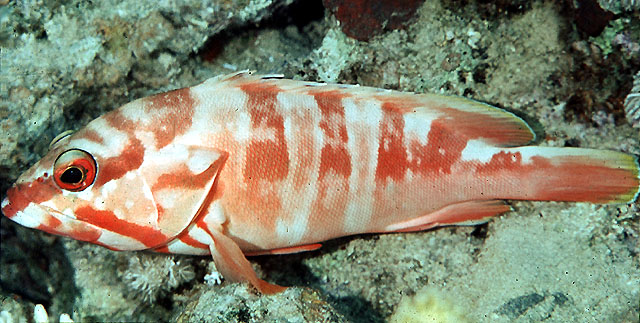| Epinephelidae (Groupers) |
| 52 cm TL (male/unsexed); max.weight: 2,000.0 g |
|
reef-associated; brackish; marine; depth range 4 - 160 m |
| Indo-Pacific: Red Sea to South Africa and eastward to the Pitcairn Group, north to Japan and Korea, south to the Arafura Sea (Ref. 9819), southern Queensland (Australia) and Lord Howe Island. |
|
Dorsal spines (total): 11-11; Dorsal soft rays (total): 15-17; Anal spines: 3-3; Anal soft rays: 8-8. This species is distinguished by the following characters: body depth 2.8-3.3 in SL (for specimens 10-26 cm SL); head length 2.3-2.6 in SL; flat interorbital area, convex dorsal head profile; snout length 4.3-5.1 in HL; preopercle rounded, rear edge serrate, with lower most serrae slightly enlarged; upper edge of operculum straight; midlateral part of lower jaw with 2-4 rows of teeth; gill rakers of first gill arch 6-8 + 15-17; pyloric caeca 10-16; caudal fin slightly to moderately rounded (Central-Pacific often with truncate caudal fins); ctenoid scales on body except cycloid anterodorsally above lateral line and on thorax and ventrally on abdomen, with numerous auxiliary scales; nape and dorsoposterior part of head densely covered with minute auxiliary scales; lateral-line scales 49-75. Colour variable, ranging from pale greenish grey to pale reddish yellow to scarlet; body often with 5 or 6 faint dark bars, the last on peduncle; body scales (except ventrally) with pale centre and dark rear margin, producing a faint checked pattern; the outer triangular part of interspinous membranes of dorsal fin black (dark red in fish from Western Australia and in some specimens from deep water), with pale yellow or white spot behind tip of each spine (Ref. 39231, 89707, 90102). |
| Common in outer reef slopes at depths below 15 m, also occurs in protected bays and lagoons as shallow as 4 m. May also be found down to a depth of 160 m. At Madagascar it feeds night and day on brachyuran crabs, fishes, shrimps, and galatheid crabs (Ref. 6774). In Kenyan waters it feeds on crabs, stomatopods, fishes, ophiuroids, and octopus (Ref. 6448). In the Red Sea, mostly fishes and some crustaceans (mainly crabs) are consumed (Ref. 6699). Readily caught with hook-and-line, spear, traps, and gill nets (Ref. 39231).. |
|
Least Concern (LC); Date assessed: 21 November 2016 Ref. (130435)
|
| reports of ciguatera poisoning |
Source and more info: www.fishbase.org. For personal, classroom, and other internal use only. Not for publication.

